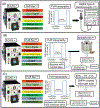Influence of puff topographies on e-liquid heating temperature, emission characteristics and modeled lung deposition of Puff Bar™
- PMID: 37969359
- PMCID: PMC10641718
- DOI: 10.1080/02786826.2023.2190786
Influence of puff topographies on e-liquid heating temperature, emission characteristics and modeled lung deposition of Puff Bar™
Abstract
Puff Bar™, one of the latest designs of e-cigarettes, heats a mixture of liquid using a battery-powered coil at certain temperatures to emit aerosol. This study presents a mass-based characterization of emissions from seven flavors of Puff Bar™ devices by aerosolizing with three puff topographies [(puff volume: 55 < 65 < 75-mL) within 4-seconds at 30-seconds interval]. We evaluated the effects of puff topographies on heating temperatures; characterized particles using a cascade impactor; and measured volatile carbonyl compounds (VCCs). Modeled dosimetry and calculated mass median aerodynamic diameters (MMADs) were used to estimate regional, total respiratory deposition of the inhaled aerosol and exhaled fractions that could pose secondhand exposure risk. Temperatures of Puff Bar™ e-liquids increased with increasing puff volumes: 55mL (116.6 °C), 65 mL (128.3 °C), and 75mL (168.9 °C). Flavor types significantly influenced MMADs, total mass of particles, and VCCs (μg/puff: 2.15-2.30) in Puff Bar™ emissions (p < 0.05). Increasing puff volume (mL:55 < 65 < 75) significantly increased total mass (mg/puff: 4.6 < 5.6 < 6.2) of particles without substantially changing MMADs (~1μm:1.02~0.99~0.98). Aerosol emissions were estimated to deposit in the pulmonary region of e-cigarette user (41-44%), which could have toxicological importance. More than 2/3 (67-77%) of inhaled particles were estimated to be exhaled by users, which could affect bystanders. The VCCs measured contained carcinogens-formaldehyde (29.6%) and acetaldehyde (16.4%)-as well as respiratory irritants: acetone (23.9%), isovaleraldehyde (14.5%), and acrolein (4.9%). As Puff Bar™ emissions contain respirable particles and harmful chemicals, efforts should be made to minimize exposures, especially in indoor settings where people (including vulnerable populations) spend most of their life-time.
Figures





References
-
- Asgharian B, Rostami AA, Price OT, and Pithawalla YB. 2018a. Regional deposition of inhaled aerosol constituents from Electronic Nicotine Delivery Systems (ENDS) in the respiratory tract. J. Aerosol Sci 126:7–20. doi:10.1016/j.jaerosci.2018.08.006. - DOI
-
- Asgharian B, Price OT, Rostami AA, and Pithawalla YB. 2018b. Deposition of inhaled electronic cigarette aerosol in the human oral cavity. J. Aerosol Sci 116: 34–47. doi:10.1016/j.jaerosci.2017.11.014. - DOI
-
- Aslaner DM, Alghothani O, Saldana TA, Ezell KG, Yallourakis MD, MacKenzie DM, Miller RA, Wold LE, and Gorr MW. 2022. E-cigarette vapor exposure in utero causes long-term pulmonary effects in offspring. Am. J. Physiol. Lung Cell. Mol. Physiol 323 (6):L676–L682. doi:10.1152/ajplung.00233.2022. - DOI - PMC - PubMed
-
- Avino P, Scungio M, Stabile L, Cortellessa G, Buonanno G, and Manigrasso M. 2018. Second-hand aerosol from tobacco and electronic cigarettes: Evaluation of the smoker emission rates and doses and lung cancer risk of passive smokers and vapers. Sci. Total Environ 642: 137–47. doi:10.1016/j.scitotenv.2018.06.059. - DOI - PubMed
Grants and funding
LinkOut - more resources
Full Text Sources
Other Literature Sources
Research Materials
